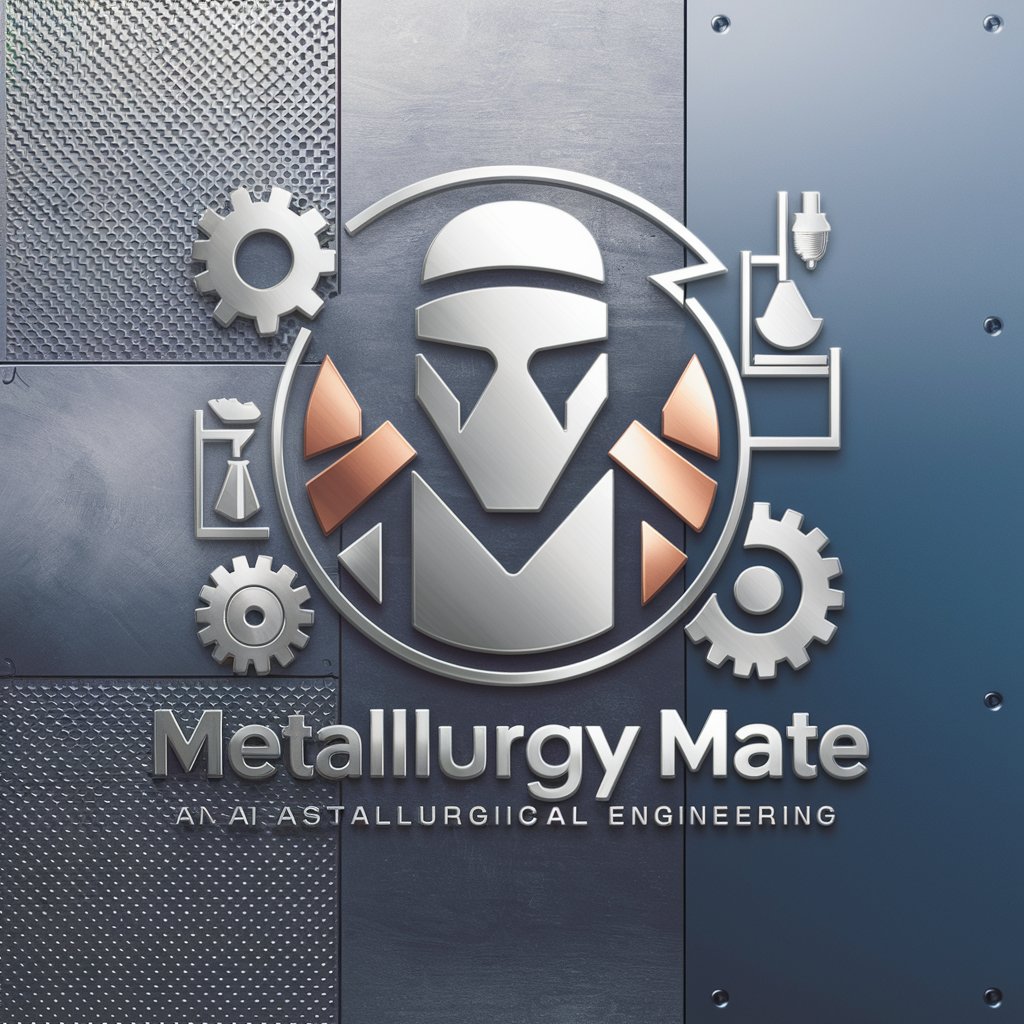
Metallurgy Mate-AI-powered metallurgy tool for analysis
AI-driven tool for material science analysis

Metallurgy expert for students and professionals, providing tailored insights.
What's the role of carbon in steel?
How does heat treatment affect metal properties?
Explain the process of aluminum smelting.
Discuss recent innovations in metallurgical engineering.
Get Embed Code
Introduction to Metallurgy Mate
Metallurgy Mate is an advanced digital tool designed to streamline and enhance the work processes of professionals and researchers in the field of metallurgy. It provides a comprehensive platform for materials analysis, testing, and data interpretation, offering deep insights into the properties and behaviors of various metals and alloys. The tool is built to support tasks ranging from routine quality control in manufacturing to complex research on new material innovations. The primary goal of Metallurgy Mate is to optimize material selection, improve processing techniques, and ensure quality standards in metallurgy. For example, a metallurgist can use Metallurgy Mate to analyze the microstructure of a steel alloy, predict its behavior under stress, and suggest ideal heat treatment processes to improve its properties. The platform serves as a guide, decision-support system, and analytical assistant for anyone working with metals.
Main Functions of Metallurgy Mate
Material Property Analysis
Example
MetallurgyMetallurgy Mate overview Mate helps assess the mechanical, thermal, and chemical properties of a material.
Scenario
A manufacturing engineer needs to assess the tensile strength and corrosion resistance of a new alloy being developed for aerospace applications. Using Metallurgy Mate, the engineer can input data about the material's composition and processing history to predict its behavior under extreme conditions, saving time in experimental testing.
Phase Diagram Prediction
Example
Metallurgy Mate can generate phase diagrams to predict the equilibrium states of alloys under different temperature and pressure conditions.
Scenario
In the development of a high-performance stainless steel alloy, a researcher uses Metallurgy Mate to predict how the alloy will behave at different temperatures and concentrations of alloying elements. This allows the researcher to design the alloy's composition with confidence that it will meet the required thermal and mechanical properties without the need for extensive trial-and-error testing.
Failure Analysis and Prediction
Example
The tool can simulate and predict how materials will fail under various loading conditions.
Scenario
A quality control team in a metal fabrication plant uses Metallurgy Mate to evaluate how a batch of forged components might fail under cyclic loading. By simulating different stress conditions, they can predict potential failure modes, such as fatigue cracking or wear, and make adjustments to the production process to improve component durability.
Heat Treatment Optimization
Example
Metallurgy Mate aids in determining the optimal heat treatment processes for different metals.
Scenario
A metallurgist working for an automotive company needs to optimize the heat treatment process for a batch of gears made from high-carbon steel. By inputting the material’s chemical composition and required mechanical properties, Metallurgy Mate helps the user determine the best combination of heating temperature, time, and cooling rates to achieve the desired hardness and wear resistance.
Alloy Design and Simulation
Example
The platform helps users design new alloys by simulating the effects of different elements on material properties.
Scenario
A materials scientist working in a research lab aims to create a new alloy for use in high-temperature turbine blades. By inputting various elemental compositions into Metallurgy Mate, the scientist can simulate how different combinations of metals like nickel, chromium, and cobalt will affect the alloy’s high-temperature stability and oxidation resistance.
Ideal Users of Metallurgy Mate
Metallurgists and Materials Scientists
Metallurgists and materials scientists are the primary users of Metallurgy Mate, as it provides a comprehensive set of tools for analyzing and developing metals and alloys. These professionals benefit from the tool’s ability to predict material properties, optimize heat treatment processes, and simulate alloy behavior without needing to perform exhaustive physical experiments. This leads to time and cost savings in both research and industrial applications.
Quality Control Engineers
Quality control engineers in industries like aerospace, automotive, and manufacturing benefit from Metallurgy Mate's predictive capabilities to ensure that materials meet strict performance and safety standards. The ability to predict material failure modes, assess fatigue resistance, and evaluate long-term performance allows these engineers to make data-driven decisions to improve product reliability and minimize defects.
Manufacturers and Production Engineers
Manufacturers, particularly those in metal fabrication, casting, and forging industries, can use Metallurgy Mate to optimize their production processes. Whether it's ensuring that the right alloy composition is used, or determining the best heat treatment protocols, Metallurgy Mate helps these users streamline operations, reduce material waste, and improve the final product’s quality and performance.
Researchers and Academia
Academic researchers and universities that focus on metallurgy, material science, and engineering can benefit from Metallurgy Mate’s in-depth analysis and simulation tools for investigating new materials or enhancing existing ones. The platform aids in quickly generating reliable data for publications, supporting experimental designs, and advancing knowledge in the field of metallurgy.
Engineering Students and Interns
Students studying materials science, metallurgy, and engineering can use Metallurgy Mate as a learning tool to better understand material properties, phase diagrams, and failure analysis. The tool serves as a hands-on learning platform, allowing students to simulate and visualize material behaviors in a controlled, low-risk environment.
How to UseMetallurgy Mate usage guide Metallurgy Mate
Visit the website for a free trial
Head to aichatonline.org to access Metallurgy Mate’s free trial. No login or subscription to ChatGPT Plus required for this trial, ensuring easy access to the tool without any initial commitments.
Select the service or feature
Once on the site, choose the specific metallurgy-related feature you need, such as material property analysis, phase diagrams, or thermodynamic calculations. The platform offers various specialized tools for different aspects of metallurgy.
Input your data or parameters
For most applications, you will need to provide relevant material data, such as alloy composition, temperature range, or specific conditions for testing. This data will be used to generate results specific to your query.
Review the generated analysis
After inputting the necessary data, Metallurgy Mate will process the information and provide an output that could include visual diagrams, charts, or textual analysis, depending on the service chosen.
DownloadHow to use Metallurgy Mate or share your results
Once your results are ready, you can download them for further review or use them directly in your research, presentations, or projects. Many features also allow for sharing the results with colleagues or collaborators via email or link.
Try other advanced and practical GPTs
Eleven Labs - Text-to-Speech enhancer
AI-powered studio for hyper-realistic speech

GPTofGPTs
AI-powered solutions for every need.

特許図面風イラストメーカー
AI-powered tool for precise patent drawings

AutoExpert (Dev)
AI-powered solutions for seamless workflows

文案GPT
AI-powered content creation at your fingertips.

DoctorGPT
AI-powered medical insights and explanations.

LinkedIn Message Assistant
AI-powered concise LinkedIn outreach — personalize at scale

✏️ Linkedin Post Creator ✏️
AI-powered tool to create impactful LinkedIn posts

Специалист по сегментации аудитории
AI-powered audience segmentation at your fingertips.

ZeroGPT
AI-powered tool for detecting AI-generated text.

Cringe Crafter
Create cringy, viral content with AI.

강아지 화가 🐶
Create personalized dog art with AI

- Research Assistance
- Educational Use
- Material Analysis
- Phase Diagram
- Thermodynamic Calculations
Frequently Asked Questions about Metallurgy Mate
What is Metallurgy Mate used for?
Metallurgy Mate is an AI-powered tool designed to assist with various metallurgy-related tasks such as material property analysis, thermodynamic calculations, and phase diagram creation. It helps users make informed decisions in material science and engineering by processing complex data quickly and accurately.
Do I need a subscription to use Metallurgy Mate?
No, Metallurgy Mate offers a free trial that allows you to access its features without needing a subscription or login, so you can explore its capabilities before deciding on any paid plans.
What types of data can I input into Metallurgy Mate?
Metallurgy Mate accepts a variety of inputs including alloy composition, material properties, temperature ranges, and other specific parameters relevant to metallurgy analysis. This data is used to generate phase diagrams, calculate properties, and provide detailed material insights.
Can I use Metallurgy Mate for educational purposes?
Yes, Metallurgy Mate is well-suited for educational use. It can assist students, educators, and researchers in metallurgy by providing clear, visual outputs and facilitating complex material analysis, making it an excellent tool for teaching and learning.
Is there any technical support available for Metallurgy Mate?
Yes, Metallurgy Mate offers customer support through email and an online knowledge base. Users can contact the support team for help with troubleshooting, technical questions, or guidance on using specific features of the tool.






